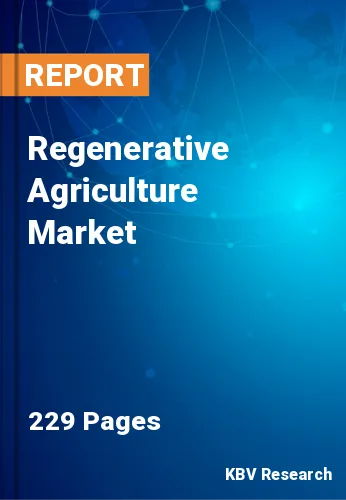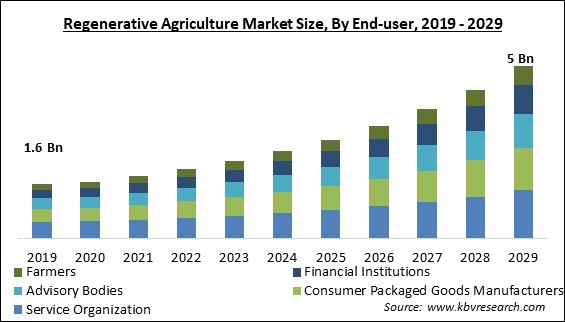
The Global Regenerative Agriculture Market size is expected to reach $5 billion by 2029, rising at a market growth of 14.4% CAGR during the forecast period.
Silvopasture is a promising type of Regenerative Agriculture method as it can improve water quality and increase species diversity (such as quail and turkey). While supplying organic matter to the soil to enhance its qualities, the forage shields the soil from wind and water erosion. Hence, it would capture approximately 1/5th share of the market by 2029. The use of regenerative farming methods resulted in enhanced crop health and production, which were partially attributed to better soil health. In addition, the profitability of farms and ranches increased due to lower usage of chemicals, including fertilizers, pesticides, herbicides, and antibiotics. Given its advantages, regenerative agriculture is anticipated to be used by more farmers, accelerating market growth. Some of the factors impacting the market are increase in support by government, farmer welfare associations, and various organizations, increasing R&D on using biologicals to sequester carbon, and Challenges in the value chain and marketing of goods from regenerative agriculture.

The governments of several countries are striving to encourage sustainable agriculture methods to reduce the carbon footprint caused by agricultural activities and, at the same time, to enhance agricultural productivity to meet the rising demand for food. Numerous government-funded programs promote traditional indigenous methods that require less input from outside sources. Comparing microbial activity to other carbon sequestration strategies, they are the most efficient at trapping carbon. There is no need for additional equipment, room, or energy during the sequestration process. Hence, the use of biological carbon sequestration is anticipated to increase the usage of regenerative agriculture, which will fuel the expansion of the market, as it can reduce the amount of CO2 in the atmosphere while also increasing plant growth.
However, customers are unwilling to pay more for products manufactured using sustainable techniques since upstream demand is unpredictable. The largest single issue across the bulk of the nation is claimed to be the systemic infrastructure that surrounds large-scale agriculture and frequently supports commodity systems and large-scale monoculture.
Based on component, the regenerative agriculture market is segmented into solutions and services. The services segment acquired a substantial revenue share in the regenerative agriculture market in 2022. This is due to the fact that these operations include soil testing, crop planning, pest and water management, disease management, and the restoration of wildlife habitats, among others. Ecologists, agricultural consultants, soil scientists, and other subject-matter specialists frequently offer these services.

On the basis of type, the regenerative agriculture market is divided into agroforestry, silvopasture, aquaculture/ocean farming, no-till & pasture cropping, holistically managed grazing, biochar and others. The agroforestry segment held the highest revenue share in the regenerative agriculture market in 2022. This is owing to the importance of agroforestry, to unify trees, crops, and cattle into one farming system. This strategy has grown in favor recently to enhance the sustainability of agricultural production overall while also enhancing soil health and biodiversity. Agroforestry is crucial in regenerative agriculture for encouraging lucrative and sustainable farming methods.
By end-user, the regenerative agriculture market is classified into farmers, service organization, financial institutions, advisory bodies and consumer packaged goods manufacturers. The financial institutions segment acquired a promising growth rate in the regenerative agriculture market in 2022. This is due to the fact that biodiversity offers finance alternatives such as cost reductions, new sources of income, and, more crucially, improved climate resilience and hedging against climate-related risks from biodiversity loss in addition to reducing financial risks. Additionally, investing in biodiversity increases the earth's resilience to handle extreme weather extremes and the rising demand for resources and energy.
| Report Attribute | Details |
|---|---|
| Market size value in 2022 | USD 2 Billion |
| Market size forecast in 2029 | USD 5 Billion |
| Base Year | 2022 |
| Historical Period | 2019 to 2021 |
| Forecast Period | 2023 to 2029 |
| Revenue Growth Rate | CAGR of 14.4% from 2023 to 2029 |
| Number of Pages | 229 |
| Number of Table | 399 |
| Report coverage | Market Trends, Revenue Estimation and Forecast, Segmentation Analysis, Regional and Country Breakdown, Companies Strategic Developments, Company Profiling |
| Segments covered | Component, Type, End-user, Region |
| Country scope | US, Canada, Mexico, Germany, UK, France, Russia, Spain, Italy, China, Japan, India, South Korea, Australia, Malaysia, Brazil, Argentina, UAE, Saudi Arabia, South Africa, Nigeria |
| Growth Drivers |
|
| Restraints |
|
Region-wise, the regenerative agriculture market is analyzed across North America, Europe, Asia Pacific, and LAMEA. The North America region registered the highest revenue share in the regenerative agriculture market in 2022. This is because the goal of regenerative agriculture in North America is to increase biodiversity, soil health, and the sustainability of agricultural systems. Expanding certification schemes and labels that demonstrate adherence to regenerative principles is one sign of the development of regenerative agriculture in North America. The growing number of businesses and investors concentrating on regenerative methods is another indicator of the expansion of regenerative agriculture.
Free Valuable Insights: Global Regenerative Agriculture Market size to reach USD 5 Billion by 2029
The market research report covers the analysis of key stake holders of the market. Key companies profiled in the report include Nestle S.A, Danone, S.A., General Mills, Inc., Cargill, Incorporated, Unilever PLC, Terramera, Inc., Soil Capital Ltd, Indigo Ag, Inc., and Grounded.
By End-user
By Component
By Type
By Geography
The Market size is projected to reach USD 5 billion by 2029.
Increasing R&D on using biologicals to sequester carbon are driving the Market in coming years, however, Challenges in the value chain and marketing of goods from regenerative agriculture restraints the growth of the Market.
Nestle S.A, Danone, S.A., General Mills, Inc., Cargill, Incorporated, Unilever PLC, Terramera, Inc., Soil Capital Ltd, Indigo Ag, Inc., and Grounded.
The Aquaculture/Ocean Farming market has shown the high growth rate of 14% during (2023 - 2029).
The Solution market is leading the Global Regenerative Agriculture Market by Component in 2022 thereby, achieving a market value of $3.1 billion by 2029.
The North America market dominated the Global Regenerative Agriculture Market by Region in 2022 thereby, achieving a market value of $1.9 billion by 2029.
Our team of dedicated experts can provide you with attractive expansion opportunities for your business.
